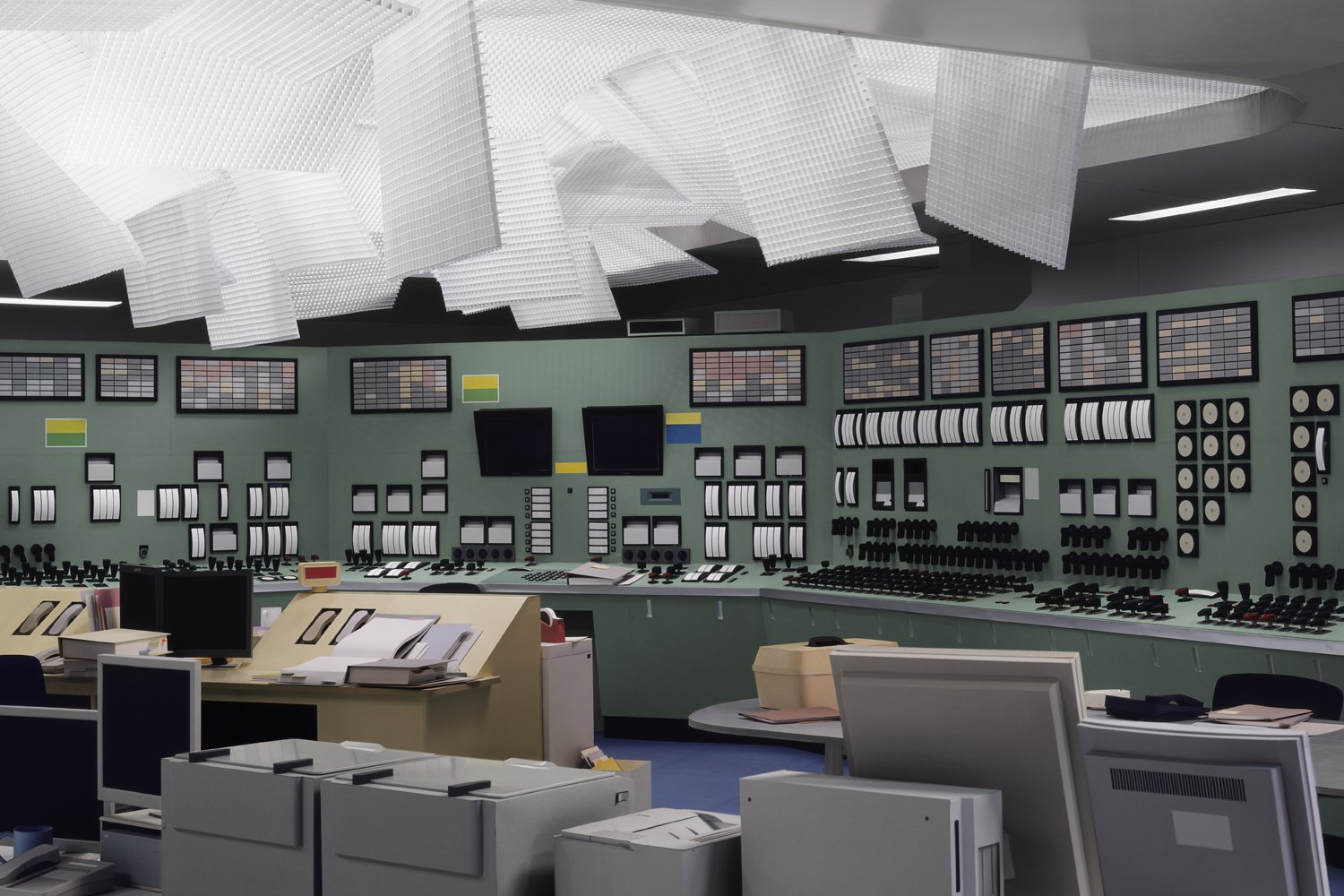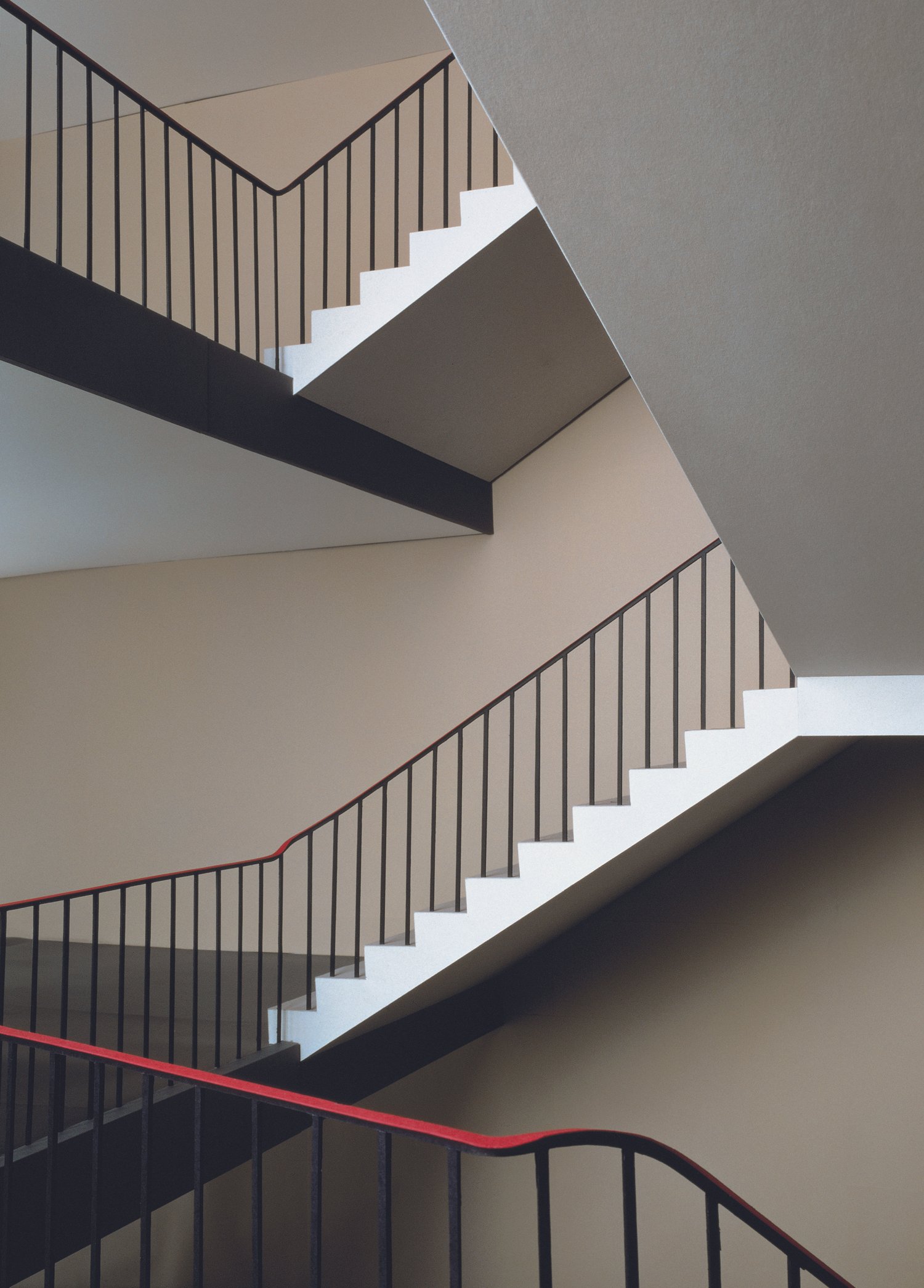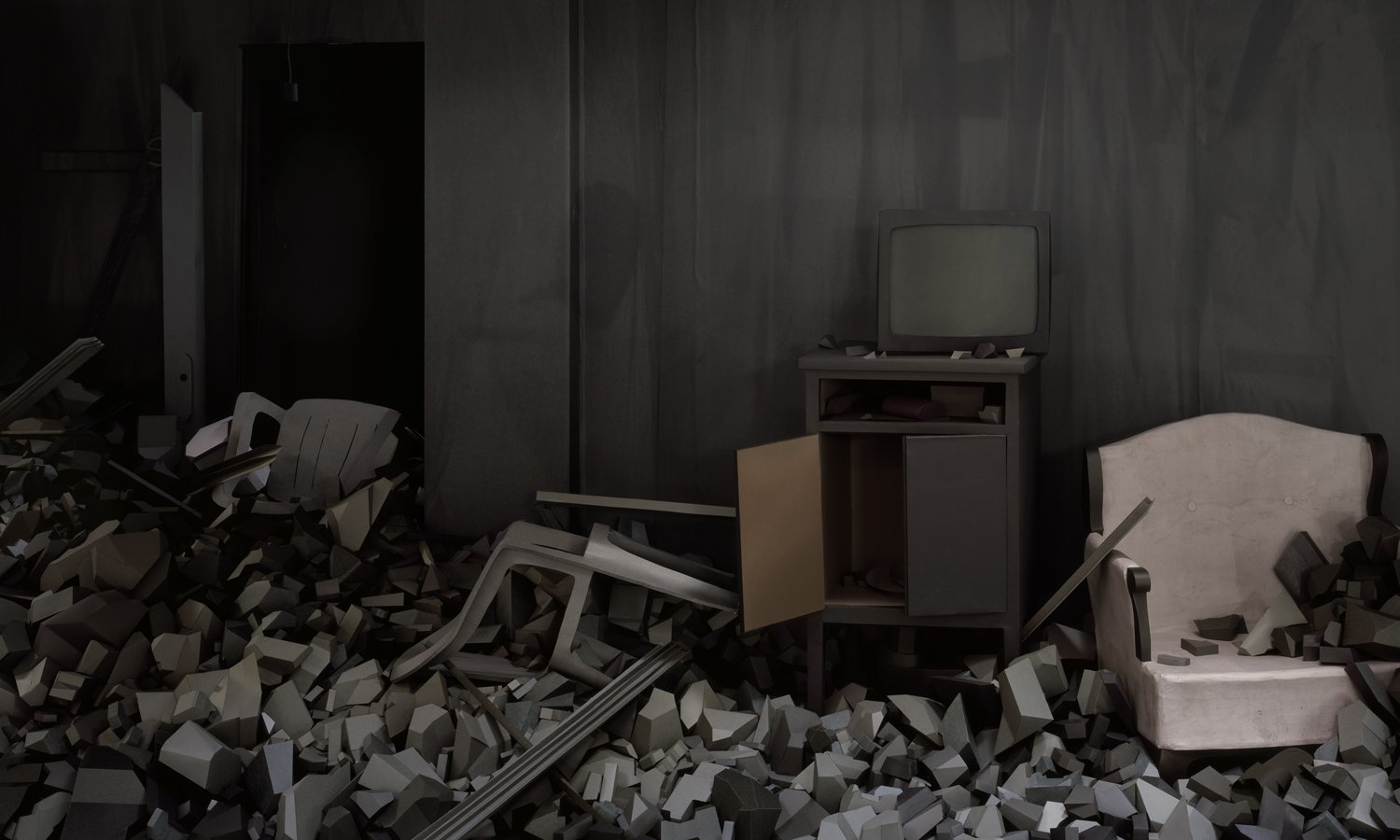THOMAS DEMAND: WEIGHT AND AMBIVALENCE

Portrait by Brigitte Lacombe, 2015
STEVE MILLER: I first encountered your work in your New York exhibitions in the late 1990’s. At that time Baudrillard’s Simulacra and Simulations was an influential book and the lens through which I viewed your work. One of the first images I saw was Diving Board, 1994. This image seemed to reflect Baudrillard’s idea that through media our primary reality had been usurped by signs and symbols. Secondary reality (mediated reality) has altered the current understanding of our lives. Were you reading Barthes, Baudrillard and critical theory or were you aware of this discourse? In his recent essay on the Dallies, Hal foster also discusses “the mediated world as a given.” Were you thinking this when you started out?
THOMAS DEMAND: When I started out, I read Wittgenstein, Carnap, Bertrand Russell, and other analytical philosophy. From there I moved to thinkers like Nelson Goodman, Villem Flusser and of course Baudrillard. In retrospect I’d say his contributions were of enormous importance to a cultural discourse at the time, but I kept a distance; he felt too cynical, feulletonistic and in that sense too opinionated for me. I wanted to find out and think, not digest judgments with my reading. Barthes was an inspiration to me when I was already more involved in photography. For my sculptures, which I was doing in the beginning, he wasn't relevant. In all, one has to admit that an artist isn’t a scholar, he will have a different approach and understanding than a philosophy student.

Thomas Demand, Daily #22, 2014; © Thomas Demand, VG Bild-Kunst, Bonn. ©Thomas Demand, VG Bild-Kunst.
STEVE: Early on, I understand there was the practical nature of making work quickly and cheaply and the photograph documents the existence of your physical efforts. However, with Diving Board, it’s hard not to think of the heroic idealism and propaganda of Leni Riefenstahl relating to the German Olympics. While I read you were not thinking about this at the time, you certainly explored these avenues of power and propaganda in later images. If not with Diving Board, what was your motivation that developed this theme in your work?
THOMAS: The development of my work as such – making larger paper sculptures and photographing them – was a result of special and economic restraints, but also not wanting to work on monumental and lasting objects which I would have to take care of from then on. It just didn't seem right to put my efforts on that aspect, although that has of course conceptual consequences which I was fully aware of. However, of course I was considering what the iconic content of the work was, despite its physical making. Especially a little later in the process of finding my way, with works like Diving board, Staircase or Raum, I was fully aware of the weight and ambivalence of these images.

Thomas Demand, Kontrollraum / Control Room, 2011; ©Thomas Demand, VG Bild-Kunst.
STEVE: So, there is this slippage that happens in your work. In some ways it’s similar to issues around the Warhol Brillo box about which Arthur Danto wrote in a wonderful essay. When people first saw the Warhol Brillo boxes, to some viewers, it seemed like that were looking at the real grocery store Brillo boxes in an art gallery. For Danto, it begs the question why would Warhol bother to make his Brillo box to look like a real Brillo box? Danto’s observation is that the differences between the grocery store boxes and the Warhol boxes initiates a philosophical discussion about the nature of reality and what’s “real.” I guess we’re back to Baudrillard. In your work how do you think about the nature of reality or your encounter with it through art?
THOMAS: I like to think that my images are very frank about the fact that they show a fabrication. They are only intended to document what has been happening in my studio at some point. That's still a reality, but not the reality of their epistemological reference. In other words, it is something, but it is not pretending to be what it looks like. Danto’s text and the one about the red square, etc. were very sharp arguments, but they have been trying to analyze something with an academic toolset which somewhat killed the enthrallment an artwork also has to have. When I started out, the Brillo boxes were 30 years old, fully understood and digested as an intellectual proposition, but they were still auratic artworks.

Thomas Demand, Daily #15, 2011. ©Thomas Demand, VG Bild-Kunst, Bonn
STEVE: The other interesting phenomenon is that in both the Warhol boxes and your photographs you have to physically look with greater concentration at the images to discover, what a first glace looks real, is actually a simulation. Because of this, you look with more intensity and focus than with other images we come across in our normal lives. I think Bonnard also consciously constructed his paintings to interrupt the normal flow of looking. How much is this part of your thought process when building your models?
WHAT'S REALLY KEY FOR ME IS THAT THE VIEWING ISN'T DOMINATED BY THE VANITY OF ITS MAKER
THOMAS: It is indeed one of my categories to make decisions. What’s really key for me is that the viewing isn’t dominated by the vanity of its maker. I am not showing off. The images have their own logic, but they also should not try to fool you. Also, I am still considering a large part of my work sculptural, so the objects I make have to be good objects in themselves, not only in a photograph. That takes a little longer, but I do think a good part of that persistency you describe is caused in that translation of the two dimensional to the three dimensional and back.
STEVE: One of the reasons I look harder at your images is the surprise in discovering the erasure of detail. We are used to cleaned up images with Photoshop and the retouching of wrinkles to control our image. In your work, with extraneous details eliminated, the viewer experiences traces of the real world. How does that change the way you want your viewer to look at and understand images?
THOMAS: As if you remember something, not as a factual proof. That's why I also felt drawn to literature over the years, I recognize a similar approach to reality and experience.
STEVE: In the development of photography, it is traditional to “take” a photograph. You turn this assumption around by building and “making” a photograph. How do you think about the difference between these two different approaches as an evolution of looking?
THOMAS: I just think things enter the reality through photography.

Thomas Demand, Daily #27, 2016. ©Thomas Demand, VG Bild-Kunst, Bonn

Thomas Demand, Daily #28, 2016. ©Thomas Demand, VG Bild-Kunst, Bonn
STEVE: The world has changed greatly since you first starting making photographs. This is the decade of illusion on a global scale. We live in a world of fake news where opinion replaces fact. Belief is more powerful than the truth. Inadvertently or not, your work now taps into this discourse. Things are not what they seem. What is the drive to create a fictitious environment?
THOMAS: For me it is to take a step back, to watch yourself watching if you like. This topic, the fictitious, has morphed over the last two decades but always mirrored the then current state of the public mind. When my work became known, the fear of being manipulated was connected to the appearance of Photoshop and the disappearance of the analogue photo. I tried to stay away from shows titled “True or False?” or “the end of photography” etc. I was trying to make that phenomenon productive and at the same time not letting the technology and the awe which comes with it becoming the overtone of my work, because in the end technology is trivial. Then the proliferation of images and how we learn or don't learn to navigate through “the ocean of images,” which of course meant that we became all senders as much as receivers. The fake news movement is just a consequence of the emphasis onto the subjectiveness, the fragmentation of society, the bubbles and so on. I haven’t even mentioned what the impact of computer aided realities had, the perfection of modelling in all our aspects of civilization and so on.

Thomas Demand, Backyard, 2014. ©Thomas Demand, VG Bild-Kunst, Bonn
STEVE: There is wonderful irony, trickery and amusement in your work. What’s the role of humor for you in your photographs and it’s ability to spark commentary?
THOMAS: I try to have the spectrum of possibilities in my work which includes the humorous. However, humor in art is a contagious disease, there are plenty of examples where the artist worked a much wider range of expression but people would look out for the joke: picabia, polke and prince, for example.
STEVE: There is also the “ah hah” moment when you discover what you think is a photo moment frozen in time is actually a meticulous construction. A viewer can get lost in investigating how the illusion of the real world is created in your work. This is the part of looking harder transformed into the joy of looking. All significant art makes you look a little longer. You may create a simple image, such as in the Dailies and get lost in comparing what you see with what you know. How much of this viewer experience is just an inevitable as part of your process and is it important to question the viewer experience?
I JUST THINK THINGS ENTER THE REALITY THROUGH PHOTOGRAPHY
THOMAS: That's central, but it has to be carefully calibrated: if that element is too dominant, it will be just about that. Then that experience won’t get beyond the artifice, the craft. But at the same time the image must keep its attraction beyond the “ah hah,” as you call it. It needs to fall apart beautifully in front of your eyes. Then the narrative layers complicate that equilibrium, but they enrich it as well. The dailies don't have a narrative other than what’s in the picture, underlying reference unlike the larger works I made. But it still needs to hold up, and I think you are quite on the spot how you described in the above how they do so.
STEVE: AI brings up another interesting issue in your work. AI cannot be trusted because it can scrape fact and fiction in illusive combinations. The result is not something that can be trusted as real. While not referencing AI, Douglas Fogle in a parallel thought calls this “the precarious construction of history.” How important is trust and how is that part of the art of looking?
THOMAS: Trust is essential, the image needs to be taken seriously. That is an ingredient like bronze for Rodin. If you are serious, people might listen and be curious what you have to show. That's the beginning of a conversation, so to say, between what you see and what you remember.

Thomas Demand, Diving Board, 1994; ©Thomas Demand, VG Bild-Kunst, Bonn

Thomas Demand, Staircase, 1995. ©Thomas Demand, VG Bild-Kunst, Bonn

Thomas Demand, Daily #34, 2019. ©Thomas Demand, VG Bild-Kunst, Bonn
STEVE: AI may replace humans or make certain thoughts and actions less necessary. The absence of humans is what’s left after we passed by or left (= death) and the action is long gone. In your work, often, the human action has already transpired as we look at their absence on the empty stage. There are so many thoughts about absence and presence when looking at your work. How are you consciously creating this dynamic?
THOMAS: I assume it has to do with the different temporalities you see at once in my pictures: what was there, what is lost and to which moment does the picture refer to. in the end all has to go, and that's very clearly visible in my work.
STEVE: Is there a question you wonder why no one has ever asked?
THOMAS: Do you think reality is a limited resource?

Thomas Demand, Ruine / Ruin, 2017. ©Thomas Demand, VG Bild-Kunst, Bonn






No comments:
Post a Comment